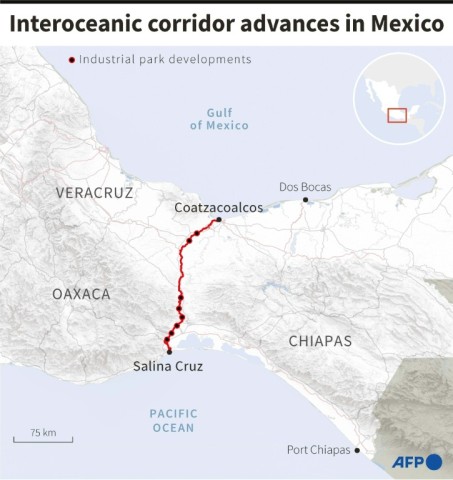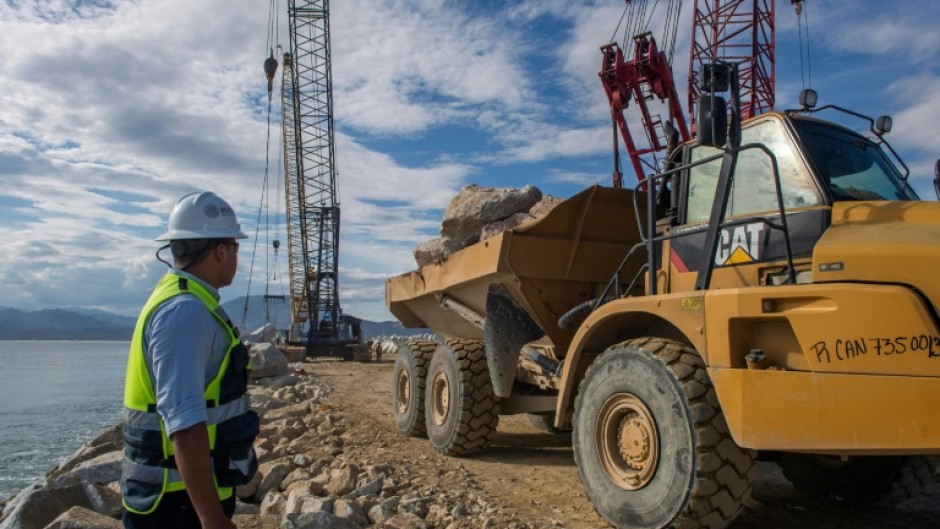SALINA CRUZ - At Mexico's narrowest point, linking the Pacific and Atlantic oceans, the government is building a railway rival to the Panama Canal with promises of economic bounty but amid fears of environmental and social harm.
The Spanish conquistador Hernan Cortes already dreamed of such a crossing for humans and goods in the 16th century, but most plans came to naught and a prior, rudimentary connection was all but abandoned with the opening of the canal cutting through Panama in 1914.
Then, in 2020, work started on a new coast-to-coast link under the government of President Andres Manuel Lopez Obrador.
It comprises a 300-kilometer railway line from the Pacific port of Salina Cruz to Coatzacoalcos on the other side of the Isthmus of Tehuantepec -- a region rich in biodiversity and Indigenous heritage.
The government has announced an investment of $2.85-billion.
According to project coordinator Adiel Estrada, it has created 800 direct jobs and some 2,400 indirect ones -- a much-needed injection for a largely impoverished part of the country.
Officials expect that once fully operational, by 2033, the "interoceanic corridor" would boost GDP by three to five percentage points.

"We will go... from one ocean to the other in seven hours," Lopez Obrador boasted of the project in a recent video recorded aboard a brand-new train.
Service is expected to start in December with two daily round trips for passengers, and three for cargo.
By 2028, the Isthmus of Tehuantepec Interoceanic Corridor (CIIT) should see 300,000 cargo containers transit every year, with 1.4 million -- about 33 million tons -- by 2033.
The 80-km Panama Canal moved about 63.2 million tons in 2022.
- 'Magnificent' -
Lopez Obrador has said the CIIT comes at a time that "our brothers in Panama are having difficulties due to water shortages" in the canal through which three percent of global maritime trade passes.
The Panama Canal Authority has had to reduce traffic to 25 ships per day starting November 3 -- down from 39 per day on average in 2022. By mid-February it will be down to 20 per day.
The Mexican corridor will be accompanied by the development of industrial parks, for which tenders have been opened, and which the government hopes will attract some $7 billion in investment.
But the corridor has had a mixed response.
"It's a magnificent project!" said Angelica Gonzalez, a 42-year-old craftswoman from Ciudad Ixtepec, one of the stops on the new route she hopes will boost sales to tourists.
Gonzalez was five years old when she last took a passenger train linking the two coasts.
That line was fully operational from 1907 to the 1950s, then declined until the 1990s when it finally closed, leaving only one cargo train on the route.
The cargo service has long been in urgent need of an update as Mexico upgrades capacity at its Atlantic and Pacific ports and the CIIT is meant to do just that.
Salina Cruz green activist Rafael Mayoral told AFP people along the route are "very motivated" for its opening.
But, he warned, that "does not erase its environmental and social impact."
According to another activist, Juana Ramirez of the Ucizoni NGO, the isthmus was likely to become polluted and downgraded by the project, with trees felled and vegetation uprooted.
Ucizoni claims that communities were not adequately consulted on the project, and that several people have already been displaced.

Ramirez said locals were being "harassed." She herself faces a large fine -- yet to be determined by a court -- for taking part in a protest against the CIIT.
Activists also fear a rise of violence in the area with organized crime likely to grow as access improves.
By mid-2024, the train is meant to link up to another line to the border with Guatemala via Chiapas -- a gateway for US-bound migrants without travel documents who frequently fall victim to smuggling gangs.
And observers claim gangs are already seizing land near the railway lines -- uprooting residents -- as they expect its value to rise.
The NGO Mexican Center for Environmental Law (CEMDA) recorded three murders of land activists between October 2022 and July 2023 which it said were linked to the corridor.
- by Jean Arce

